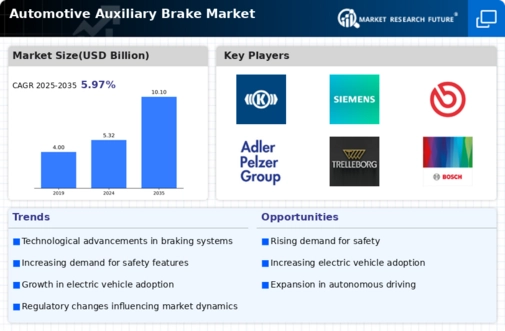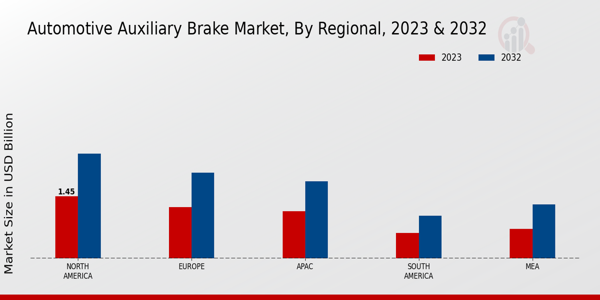Market Growth Projections
The Global Automotive Auxiliary Brake Market Industry is poised for substantial growth in the coming years. With projections indicating a market value of 5.32 USD Billion in 2024 and an anticipated increase to 10.1 USD Billion by 2035, the industry is expected to experience a compound annual growth rate of 6.02% from 2025 to 2035. This growth is driven by various factors, including technological advancements, regulatory compliance, and the rising demand for safety features in vehicles. As the market evolves, stakeholders are likely to focus on innovation and sustainability to meet the changing needs of consumers and regulatory bodies.
Regulatory Compliance and Standards
Regulatory compliance remains a driving force in the Global Automotive Auxiliary Brake Market Industry. Governments worldwide are implementing stringent regulations aimed at improving vehicle safety and environmental performance. These regulations often mandate the inclusion of auxiliary braking systems, particularly in heavy-duty vehicles. As manufacturers strive to meet these requirements, the demand for advanced auxiliary brake systems is expected to rise. This regulatory landscape not only influences product development but also shapes market dynamics, as companies that prioritize compliance are likely to gain a competitive edge. The ongoing evolution of regulations will continue to impact the market positively.
Increasing Demand for Safety Features
The Global Automotive Auxiliary Brake Market Industry experiences a notable surge in demand for enhanced safety features in vehicles. As regulatory bodies worldwide enforce stricter safety standards, manufacturers are compelled to integrate advanced braking systems, including auxiliary brakes, into their designs. This trend is particularly evident in commercial vehicles, where auxiliary brakes are essential for maintaining control during heavy loads. The industry's growth is projected to reach 5.32 USD Billion in 2024, reflecting a growing awareness of safety among consumers and manufacturers alike. Consequently, the integration of auxiliary brakes is becoming a standard practice, thereby driving market expansion.
Growth of the Electric Vehicle Segment
The rise of electric vehicles (EVs) significantly influences the Global Automotive Auxiliary Brake Market Industry. As EV adoption accelerates, the demand for efficient braking systems, including auxiliary brakes, becomes increasingly critical. Auxiliary brakes in EVs not only enhance safety but also contribute to energy regeneration, improving overall vehicle efficiency. With projections indicating that the market could reach 10.1 USD Billion by 2035, the integration of auxiliary braking systems in EVs is likely to become a standard feature. This trend underscores the importance of auxiliary brakes in supporting the transition to sustainable transportation solutions, thereby driving market growth.
Rising Awareness of Vehicle Maintenance
The Global Automotive Auxiliary Brake Market Industry benefits from a growing awareness of vehicle maintenance among consumers. As vehicle owners increasingly recognize the importance of regular maintenance for safety and performance, the demand for auxiliary brake systems rises. Properly maintained auxiliary brakes can significantly enhance vehicle safety, particularly in commercial applications where heavy loads are common. This trend is reflected in the increasing sales of auxiliary brake systems, as consumers prioritize safety and reliability. The industry's growth trajectory is likely to be bolstered by this heightened awareness, as more consumers seek to invest in advanced braking technologies.
Technological Advancements in Brake Systems
Technological innovations play a pivotal role in shaping the Global Automotive Auxiliary Brake Market Industry. The introduction of electronic braking systems and regenerative braking technologies enhances the efficiency and effectiveness of auxiliary brakes. These advancements not only improve vehicle performance but also contribute to reduced emissions, aligning with global sustainability goals. As manufacturers invest in research and development, the market is likely to witness a compound annual growth rate of 6.02% from 2025 to 2035. This growth is indicative of the industry's commitment to adopting cutting-edge technologies that enhance safety and performance, further solidifying the role of auxiliary brakes in modern vehicles.













